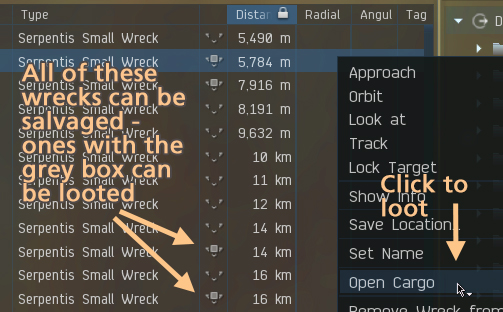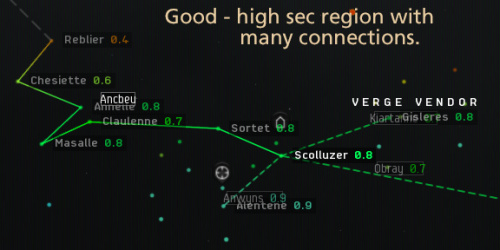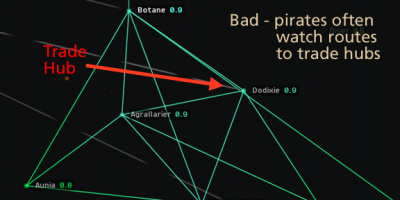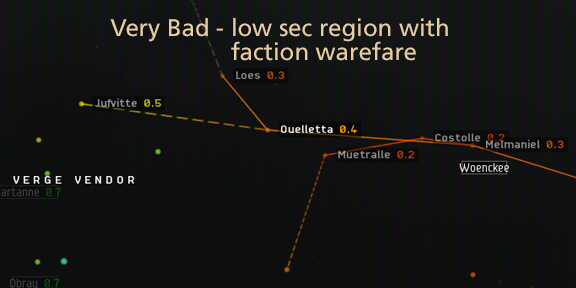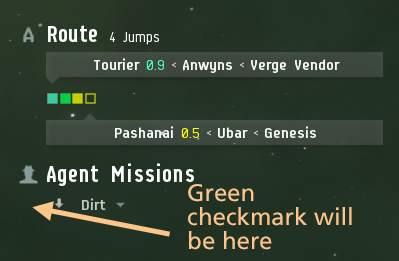A mission is a job offered by an non-playing character to a player which requires the player to accomplish a set of objectives in exchange for a set of rewards.
Rewards
These are the rewards that come from missions.
- ISK is Eve's currency. Most missions pay you in ISK.
- Killing NPC in combat missions will also pay bounties. You will often get mroe isk from bounties than from mission reward.
- Loyalty Points are a currency that you receive from the Corporation whose agent gives you a mission. These points can be used to buy things at the Corporation's store.
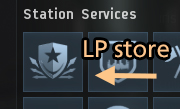
- Loot is the name given to various items that can be taken from the ships that you kill in combat missions. Loot can be sold for ISK, or it can be reprocessed into minerals that can be sold for ISK, and sometimes you can fit it to your ship and use it yourself.
- Standings are numbers that indicate how good (or bad) your reputation has become. Doing missions almost always affects your standings with agents, corporations and factions.
Mission Levels
Mission levels go from low to high: 1 to 5. As you go up in level, the missions generally require that you have more skills and access to bigger ships, but they also provide better rewards. The level of a Mission Agent tells you the level of missions that the agent will offer. Each agent offers only one level of missions.
- Level 1 is where most new players start. Most, if not all, level 1 missions can be done in a basic frigate, Only the most basic piloting skills are required.
- Level 2 mining missions stepping up from a frigate. These missions generally expect that you are continually improving your piloting skills and learning how to fit out new ships.
- Level 3 missions require a battlecruiser, a mining barge, or a medium-sized industrial ship. These missions go faster if you have trained for better ships and at least some Tech 2 fittings.
- Level 4 missions require a Battleship, an Exhumer, or a large industrial ship. These missions can be time-consuming, but they offer large rewards.
- Level 5 missions are designed for groups of players or capital ships and are exclusively located in Low Security space.
Three Common Mission Types
There are three standard types of missions: Security (sometimes also called "Encounter"), Mining, and Distribution (sometimes called "Courier").
Security missions are given out by Security Agents and they always require you to go to a location somewhere in space and complete an objective of some kind. The objective is usually to kill a ship or a set of ships, but other goals can be included. Security missions have the highest payout in ISK and Loyalty Points, and they offer the possibility of loot - but they also usually involve the possibility of death.
Mining missions are given out by Mining agents and require you to mine an asteroid or set of asteroids and bring the ore back to the agent's station. Level 1 missions will require mining up to 2000 m3 of ore; level 2s up to 6000 m3 of ore. There is a risk of combat in mining missions, though the "belt pirate" NPC hostiles that show up are usually rather weak. Note that Mining missions pay off in ISK and Loyalty points, you do not get ore from Mining missions.
Distribution missions require the movement of a cargo from one station to another. Cargo size for Level 1 and 2 missions can be up to 450 m3 in size. Distribution missions never require combat, though, of course, you may encounter PvP combat on the way to your destination.
Standings
Standings are a measure of how much one entity in EVE likes or dislikes another. These feelings are measured on a scale from -10 to +10 where negative is hatred and positive is love. Completing missions changes your standing with the agent, the agent's corporation, in some cases the agent's faction and, in security missions, the faction of the entities that you kill.
An agent will offer you missions only when your standings reach a certain amount, depending on the agent's level:
- Level 1: Any standings
- Level 2: 1.00 or higher
- Level 3: 3.00 or higher
- Level 4: 5.00 or higher
- Level 5: 7.00 or higher
Agents' standings are determined in part by your standing with their parent corporations. Because of this, there is an advantage to running your missions with the same agent. Each completed mission will raise your standing with that agent and the agent's corporation and move you more quickly towards the next level. In addition, because Loyalty Point stores are run by corporations, you will be able to buy more items faster if you stick with one corporation.
Finding Agents
Needs something
These two web-based tools offer the same data as the in-game Agent Finder, but in an easier format. (Easier once you get the hang of it!)
Storyline Missions
As you continue to complete missions, you will occasionally get a Storyline Mission offer from a special Storyline agent. This agent will suddenly appear in various stations, however, you may need to travel to the agent's station in order to accept the mission. Once you are in touch with the Storyline Agent, you accept and complete the mission in the usual way.
Storyline missions are usually simple, often requiring you to buy units of ore for delivery to the agent, and they seldom require combat.
Completing a Storyline Mission substantially increases your standings with the agent's corporation and faction.
Special missions
These mission types are not as widely available as the basic three.
Research Missions
Research missions are a part of the Industry career path. Instead of Loyalty Points, these missions award Research Points that can be used to buy datacores from the agent who gives the missions. You will need to have trained various Science knowledge to the level required by an agent before he or she will offer you the mission. Datacores can be sold in the Market, and some players run these missions to make ISK from trading. Most players, however, have not trained the science skills that these missions require.
More information on Research Missions is included in the Details section of this page.
Epic Arc Missions
An epic arc is a series of up to fifty missions which are split up into chapters. Throughout the arc, you will be offered choices which will branch the arc in one or more directions, and thus the arcs have different outcomes depending on your choices. The missions that make up these arcs typically have very good ISK rewards and the last mission of the arc typically carries a handsome reward.
There are seven Epic Mission Arcs. Most players begin with The Blood-Stained Stars, an arc that can be completed in a T1 frigate and gives a boost in standings withe Sisters of Eve.
More information on Epic Arc Missions is included in the Details section of this page.
Anomic Missions
Anomic missions (also known as "burner" missions) are optional security missions that are given out by level 4 agents. They can always be declined without penalty. Anomic missions present a different and higher challenge compared to other security missions . You will encounter a small number of very powerful adversaries and you are restricted in ship size. These missions require specialized and expensive ship fits and high skills to solo. They also require piloting skills that are otherwise rarely used in PvE such as overheating. The game re-balances these missions frequently, so it is good to research the latest fits and tactics before attempting them.
More information on Anomic Missions can be found in the Details section of this page.
Career missions
Career missions, also know as Tutorial missions, are missions that are supposed to help new players learn how to play EVE Online. It is a good idea to do these tutorials when you first start playing EVE, as they give valuable ships and equipment, and the increase your standings with the faction offering the missions.
Each player character can only do each Tutorial Mission from a given Tutorial Agent once ever, but the tutorial mission chains do count as Storylines in increasing corporation and faction standings.
COSMOS
Data Center
Advice For New Mission Runners
This section offers insights from experienced players on how to be successful as a beginning mission runner.
Starting Up a Mission
If you're new to mission running and your goal is to gain loot, or pile up loyalty points to buy things, or to increase your standing with a faction, then you may want to lay out a plan to help you run your missions with a minimum of down time. Here are some suggestions.
1. Pick An Area In Which To Work
The last thing you want is to be running missions in the middle of a contested low sec region where combatants will shoot at you, or in systems that lie on a busy trade route where pirates will gank you. Use the map and look for a group of fairly high security systems set off from the major trade routes. It's also nice to have multiple star gates nearby, just in case you need to run for it. It is also best to not be alone so pick your location near your friends.
2. Know What You Need; And Check Out What The Various Agents Offer
Successful mission runs give you ISK and Security missions can give you loot. They also give you standing with the agent that gave you the mission and the agent's corporation, and the agent's faction. And, they give you loyalty points that can be redeemed for items in the corporation's store. (For example, Roden Shipyards' missions give standings with the agent, the corporation and the Gallente Federation. And each mission gives loyalty points that can only be used in Roden's stores.)
Most corporation stores sell the same sets of augmentation implants. However, different corporations offer different sets of skill upgrade implants, and different factions offer different weapons and ammunition. Roden Shipyards, for example, sells warp drive and astrometric skill upgrades, while Astral Mining offers mining upgrades. Weapons and ammunition offers correspond to the faction's spaceship preferences - Minmitar offer projectile weapons and ammo, while Ammar offer laser weapons and crystals, and so on.
3. Pick A Corporation With Agents In The Region
Nearly every station has at least one agent, and there are many duplications in terms of standings and items offered for sale. So if you want to improve your standing with the Gallente, for example, and you want to buy some mining skill upgrades, then Astral Mining is one of the corporations you would want to consider. Since there are many Astral agents in Gallente space, choosing this corporation will not restrict your choice of star systems all that much.
Once you have a goal in mind, use the Agent Finder to narrow your choices of star system. Keep in mind that when you finish running level 1, you will almost certainly have to move to a new system to find a level 2 agent, and again for level 3. So try to find a group of level 1-2-3 agents that are fairly close together.
In the example below note that the box at the bottom left of the window is UNchecked - because you want to see all agents, not just ones that you can currently talk to. There are many level 1 agents, fewer level 2 and even fewer level 3. But it turns out that there are level 1 AND level 3 agents in Jufvitte. This is convenient. Even better, there is a level 2 agent in Gisleres - only two jumps from Jufvitte. This means that you can run the first three levels of missions at Roden Shipyards from a station in this area of space.
File:Roden agents 1.jpg File:Roden agents 2.jpg File:Roden agents 3.jpg
4. Pick A Base Station And Start Running
Here is the map for that area:
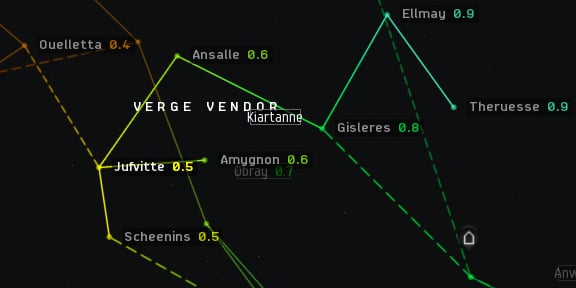
You need a base because as you go along, you will buy ships, ammunition and other gear, and you will pick up loot and junk from completed missions. It's easiest to keep all this stuff in one place, so plan to go to your agent's base to run missions, and fly back to your base when you need to refit. Missions often send you to other systems, usually in the range of 1-4 jumps from the agent's home base. This means that you will be jumping around a lot, and so there is no particular advantage to putting your base in the agent's system.
There are differing opinions on how to pick a good base station. I tend to put mine in a place where it's easy to buy ammo and ship equipment. This makes for minimum hassle if I need to upgrade equipment (because I've gained new skills), or fit out a new ship (because I've gone up a level). But the location is not terribly important ... if you're not sure where to put your base, don't worry about it. Just find an Agent and get started. The rest will work itself out as you go along.
Two hints for being sure your mission is complete
- Look for a green check mark next to the mission
- If you think the mission is finished, but you don't see the green checkmark, or if you're not sure what you need to do to finish, click on the little down-pointing arrow beside the mission name and select "details" from the menu. This will show you the mission statement and you can see what you still have to do to complete it.
Note though that some missions may not get this completion mark.
Loyalty Points
- Main article: Loyalty Points
New missioneers often forget about the Loyalty points that they gain whilst running missions. These points (plus a small amount of ISK or items) can be exchanged for valuable items in the Loyalty Points store of the mission agent's corporation.
For some players it is more profitable to accumulate Loyalty Points in order to exchange them for goods which can then be sold than it is to kill, loot and salvage in security missions. This approach also has the advantage of shortening the amount of time it takes to achieve the Standings required to run higher level Missions, which are correspondingly more profitable in Loyalty Points terms as well.
You can review your Loyalty Points in-game in the NeoCom > JOURNAL button > AGENTS tab > LOYALTY POINTS subtab.
Mission Preparation and Walkthroughs
The first rule is to never fly what you cannot afford to lose. Even distribution missions can fail if you get ganked. So fly the cheapest ship that will do the job.
You should also know the mission you are being offered. Always understand exactly what you will encounter in a mission before you accept it, because if you accept a mission without understanding it, and it turns out to be too difficult, then your only options are to get help from other players or to quit the mission. You can also lose your ship in the process of discovering that the mission is too difficult for you. If you're not sure what a mission requires, you can always go online and read an analysis or walkthrough.
Most (if not all) regular and storyline missions are documented at Eve Survival Here you can read the details of what you need to do in the mission before you accept the mission, including (most importantly) details that the agent does not tell you up front.
Know also that NPCs in missions tend to be very predictable in their setups. For example, Gallente and Serpentis use only Kinetic and Thermal damage against you, but are also most susceptible to Kinetic and Thermal damage themselves; when they use any form of Electronic Warfare (EWAR), it's always sensor dampening. It helps quite a bit if you set up your ship to deliver damage that the NPCs don't like and defend against what they will throw at you. Check out this page for a full description of NPC damage types and a handy chart that you can keep in your Neocon Notebook.
Missioning with a Fleet
- Main article: Mission Fleets
Members of a fleet who run missions can share some or all of the standings, LP, ISK, loot, and/or salvage offered by the missions. This is especially good for newer players, as they generally gain more standings than they share. There are two main kinds of mission fleet: Spider, where everyone runs their own missions, but shares standings, etc. at the end; and Locust, where the fleet members all work on the same mission together. Read the article on Mission Fleets for more details.
References
This page presents advanced mission running topics with specific descriptive details and advice for running
- level 3 and higher missions
- Epic Arc missions
- Anomic (burner) missions.
See also:
- Mission Running: Introduction for a basic introduction to missions
- Mission Ships for a discussion of the best ships to use on missions
- Mission Fleets for a description of how these fleets are set up and run.
Useful Stuff to Bring on Missions
Some items are not necessary for completing missions, but are nice to have around.
Tag/Keys: Gate Key for Dread Pirate Scarlet, Angel Pallidum Tag for L4 Angel Extravaganza bonus room, or Zbikoki's Hacker Card for Worlds Collide. When doing Locust Fleet you may not want to fly all the way back to station to pick them up. Consider carrying extra for fleet mates! (How many times have I had people warp out of the AE bonus room then be unable to get back in to help because they don't have a diamond tag?)
Warp Core Stabilizers: These are great during wartime. If your mission is in a different system than your agent, you can fill your lows with core stabs so you can escape if you jumped into some war targets (WT). When you arrive at the system your mission is in, just dock up and refit your usual low modules (which you placed in your cargo hold before you left :) ). I saved my hurricane from a WT this way (having 6 core stabs means need at least 3 scramblers and 1 disruptor to stop your warp). This isn't a good idea for just missions; it's always a good idea to keep core stabs in your cargohold. If a WT comes into your system, you can dockup, refit, then go to a different system. Remember to count: if there's 3 WTs and you have only 4 core stabs you could be scrammed. If you plan to do this, know your aggression mechanics and have a hardy shield tank.
ECM drones: Also good for wartime. If you're scrammed, try unleashing these guys. If you're lucky, the WT will lose lock and you can warp away. These go in your dronebay, not in your cargo.
Extra Mods: Most people switch resists for what rat they're against. Say you're mid-mission and discover your tank isn't so great. It's easier to refit in that system then jump back to your base to pickup extra resists. Also applies if you want more damage mods. Having an omni-shield buffer goes nice with lows full of core stabs when traveling is nice during war. Remember you have a limited cargo space, so don't go overboard.
Mobile Tractor Unit (MTU): This tool is very useful for looting and salvaging mission pockets. Bring it in your cargohold (100 m3), deploy it in a mission pocket and it will automatically collect and loot all wrecks created within 125 kilometers of itself. This also greatly increases the efficiency of salvaging by effectively eliminating the transit time for looting and salvaging, while also providing a convenient structure to orbit around during this process. When scooping the MTU, it will automatically eject any cargo it has remaining into a standard, temporary cargo container.
Standings and Agents
- Main article: NPC standings
Standings are a measure of how much one entity likes or dislikes another entity and are measured on a real number scale from -10 to +10. A standing of -10 is tantamount to complete and total loathing and conversely +10 is complete and total adoration.
Why Standings Matter
The standings of NPC entities toward a player are important for a couple reasons. Firstly, because higher standings make more profitable missions available. And secondly, because several perks become available when an individuals or player-run corporations standings are higher with a specific entity.
For an individual:
- At 5.0 all L4 Agents for that faction become available to you (4.0 with certain Corporations)
- At 6.67 you are no longer subject to the refining Equipment Tax with that corporation
- The higher your standings toward an NPC entity the lower the broker fee is in their stations. As an example, with a faction and corp standing of 10, the broker fee is reduced to 0.185%, saving you more than 1% through the buy and sell process
Standings Incremental Increase and Loss
When standings go up or down they usually do so as a percentage; this is always a percentage decay towards the extreme end of the scale. For example, if someone has 1.0 standing with an NPC corporation and completes a mission that changes standing by +5%, then the current standing is increased by 5% of the difference from +1 to +10; that's a change of +0.45 with an end result of +1.45. However, if someone else with a 4.0 standing completes the same mission under the same circumstances and also gets a 5% increase, then that's 5% of the difference from +4 to +10; that's a change of +0.30 with an end result of +4.30.
If something causes a standings decrease, then it's a percentage decay towards −10. For example, if someone with +1.0 standings suffers a −5% change, then that's 5% of the difference from +1 to −10; that's a change of −0.55 with an end result of +0.45. If someone with +4.0 standings suffers that same −5% change, then it's 5% of the difference from +4 to −10; that's a change of −0.7 with an end result of +3.3.
What this means is that gains are reduced and losses are increased incrementally as your standings become higher, and vice versa.
Declining Missions
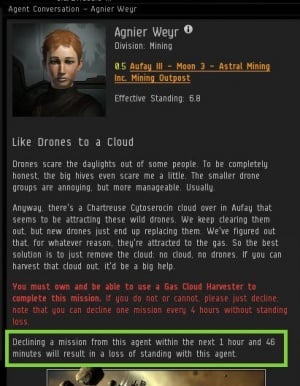
It is worth noting that running out of time on a mission you have accepted will usually cause a standings loss with the agent, corporation, and faction. Declining a mission for a particular agent more than once every four hours will also cause a standings loss with the agent, corporation, and faction.
To see a history of how your standings have changed, you can go to NeoCom > Character Sheet > Standings, scroll through the list of NPC entities, right-click an entry and select SHOW TRANSACTIONS to see how much your standings went up or down for what actions and by how much. All the percentage changes you see in the Transaction Log are as described above, with the exception that (due to a possible bug) any percentage changes due to "Derived Modification" are percentage changes of 10.0, not percentage decays towards an extreme.
Agents
All common mission agents have a name, a Level, and a Division. "Level" describes the general difficulty level of the mission that the agent can offer you and can range from 1 to 5; it also affects the standings you need to reach in order for this agent to give you missions. "Division" determines what type of mission - security (combat), distribution (hauling), or mining - you will be offered. [1]
An agent will offer you missions only when your standings reach a certain amount, depending on the agent's level:
- Level 1: Any standings
- Level 2: 1.0 or higher
- Level 3: 3.0 or higher
- Level 4: 5.0 or higher
- Level 5: 7.0 or higher
You must meet this requirement for either the agent's personal standing towards you, their corporation's standing towards you, or their faction's standing towards you; any one of the three will suffice. For example, Eveynel Daerne is a Level 3 agent in Orduin IX - Moon 4 - Transstellar Shipping Storage. This agent is part of the Transstellar Shipping corporation, which is part of the Gallente Federation faction. The standings requirement is therefore 3.0, so at least one of the following 3 conditions must be true to get missions from Eveynel Daerne:
- Eveynel Daerne's personal standing towards you is 3.0 or higher.
- Transstellar Shipping's standing towards you is 3.0 or higher.
- The Gallente Federation's standing towards you is 3.0 or higher.
The fact that Eveynel Daerne is located in the Orduin solar system, which is the sovereign territory of the Minmatar Republic, is completely irrelevant. High Minmatar Republic standings will not give you access to missions from Eveynel Daerne. This concept applies as a rule to all agents of a faction who are located in a different faction's sovereign space.
Gaining access to higher level missions can be eased by training two skills: Diplomacy (1x, 200k ISK) and Connections (3x, 200k ISK) ("Connections" is not to be confused with other social skills such as "Criminal Connections" or "Security Connections"). Diplomacy gives you a standings boost with agents, NPC corporations, and factions that dislike you to begin with, and this boost is 4% per level of the Diplomacy skill. Connections gives you a standings boost with agents, NPC corporations, and factions that like you to begin with, and this boost is 4% per level of the Connections skill. Between Diplomacy and Connections, only one will apply, but it will give a boost significant enough to ease the process of getting access to Level 2 missions.
When you complete a regular mission for an agent, you get increased standings with the agent and the corporation, but not the faction. It is worth noting that if the mission involves destroying ships or structures of a different faction, then your standings with the target faction go down due to "Combat - Ship Kill", but your standings with the agent's faction will not change. Those who wish to be able to fly in all High Security space are advised to decline all anti-Empire missions (that is, anti-Amarr, anti-Ammatar, anti-Caldari, anti-Gallente, and anti-Minmatar). Some exceptions or workarounds exist; for example, a Minmatar agent might give you the mission Friendly Spies, where if you destroy the mission objective but none of the hostile ships, then you don't lose Gallente Federation standings. In other cases, the standing losses due to "Combat - Ship Kill" are almost insignificant, such as Amarrian Tyrants, Level 3, or Against the Empire, Level 3. Some missions, though, will incur -2.4% standing losses for ship kills and might require one or more completed storyline missions for the opposing side to repair the standings losses (for example, Against The Empire, Level 1; yes, the Amarr standing loss on Level 3 is insignificant while the standing loss on Level 1 is bad; losses are only consistent for the exact same mission and level).
Storyline Missions
The game tracks how many missions you've completed for each level and each faction. For every 16 missions of the same level and faction (but not necessarily the same corporation) that you complete, you will get a new Storyline Mission offer from a Storyline Agent of the same Faction. This will always be the Storyline Agent closest to the regular agent who gave you your 16th mission (in terms of number of jumps) with two exceptions.
- First, if the closest Storyline Agent has already made you an offer that you haven't accepted or declined, then it will be the second-closest Storyline Agent that you get the offer from.
- Second, if the agent who gave you the 16th regular mission that you completed was in High Security, then the Storyline offer will always come from a Storyline Agent in High Security.
You cannot work for a Storyline Agent unless you've received an offer from that Agent.
Completing a Storyline Mission substantially increases your standings with the agent's corporation and faction. When your faction standings are increased in this way it affects the standings of friends and enemies of the faction in question toward you. The amount that the other factions standings change toward you is directly related to their affinity for or dislike of the faction that you are involved with. For example if you are increasing standings with the Gallente Federation, your standings toward the Minmatar Republic will increase by 80% of what the Gallente standing increase because the Minmatar have an 8.0 standing toward the Gallente. Note that your standing with factions which dislike the faction you just ran a mission with will decrease (by the same proportion as above), so if you don't want to alienate too many factions make sure to run missions for each of them.
When trying to increase standings with a particular NPC corporation, it is possible to plan your missioning such that when you hand in your 16th mission, you get your offer from the Storyline Agent of the corporation that you are focusing on. See Mission Hubs for examples.
High Level Security Missions
The objective of a Security mission is usually to kill a ship or a set of ships located at the encounter, but it could also be to destroy a structure, to get close to a location and then escape, to pick up an object at the location (which may or may not be an ambush), or to fly from beacon-to-beacon. Be sure to read the mission description carefully. If you find that you cannot figure out what a mission is asking you to do, consider looking at a walk-through for that particular mission.
When you accept a Security mission, the game will always create a region of space in some solar system that is populated by objects also created specifically for the mission. If you need specialized gear or items to carry, these will usually appear in the Hold of the station where you accepted the mission. If there are exceptions to these conditions, the mission statement will spell them out.
Eve Refinery is a tool that helps make the decision as to whether loot should be sold or reprocessed.
High Level Mining Missions
Mning missions require you to mine an asteroid or set of asteroids in a mission space, usually until the asteroids are depleted, and bring the ore back to the agent's station.
There is a risk of combat in mining missions, though the hostiles that show up tend to be much weaker than hostiles found in encounter missions. It is advisable to have some offensive capability (like a set of combat drones) or have a strong enough tank that you can ignore any hostiles that show up and start shooting at you.
The mission may require you to mine more ore than can fit in your cargohold; this is typical of mining missions. Level 1 missions will require mining up to Template:Gaps m3 of ore, level 2 up to Template:Gaps m3 of ore, level 3 up to Template:Gaps m3 of ore or Template:Gaps m3 of ice, and level 4 up to Template:Gaps m3 of ore, Template:Gaps m3 of ice or Template:Gaps m3 gas.
Mission mining is defined as harvesting the asteroids that are commonly found in Deadspace combat/encounter missions. The Mission Mining page of this wiki presents a complete list of these missions.
High Level Distribution Missions
A Distribution mission is a mission to take a piece of cargo from one station to another station. When a Distribution mission is accepted, the necessary cargo is spawned in your personal hangar at the pickup station. You then need to haul it to the destination ("drop off") station using your ship. Once docked at the destination station you may complete the mission by talking to the agent. The cargo only counts as delivered if it is either in your personal hangar at the destination station or in your ship's cargo hold while you are docked at the destination station.
Distribution missions never spawn any hazards of their own; you only have to deal with the normal hazards of Stargate travel (gatecamps, suicide gankers, warp interdiction bubbles on Stargates in NullSec, and so on). Level 1 missions will keep you within the agent's constellation, level 2 and level 3 will possibly send you to a neighboring constellation, and level 4 missions will always send you to a neighboring constellation. [2]
It is worth noting that although you are at the destination station you can still talk to the original agent remotely to complete the mission without going back to the original station. They will be listed in the station's "Agents" tab after you dock, or you can start a conversation with them using your mission journal. However, until you fly back and dock at their station, they will not give you a new mission.
If a Distribution mission has an item as a reward instead of ISK, then the item will appear in your personal hangar at the agent's station (which may or may not be the dropoff location for the mission).
Level 1 and 2 Distribution missions can be run using frigates, although you may need to use cargo modules in the low slots. Cargo size for L1/L2 missions can be up to 450 m3 in size. For level 3 and 4 courier missions, you will need an industrial hauler because cargo sizes will be in the Template:Gaps–Template:Gaps m3 range.
Research Missions
- Main article: Research missions
Research missions are a part of the Industry career path. Instead of Loyalty Points, these missions award Research Points that can be used to buy datacores from the agent who gives the missions. Unlike other mission agents, research agents work for you ... and you must start, and if necessary stop, their research.
See Research missions for more details.
Epic Arc Missions
An epic arc is a series of up to fifty missions which are split up into chapters. Throughout the arc, the player will be offered several choices which will branch the arc in one or more directions. The missions that make up these arcs typically have very good ISK rewards and typically the last mission of the arc carries a handsome reward.
There are seven Epic Mission Arcs. One for each of the empire factions, two for pirate factions (Angels and Guristas) and one for the Sisters of Eve corporation. The last of those is an especially good starting point for new pilots. Most of the Sisters of Eve epic arc missions can be easily solo'd in T1 fit destroyer class ship. The last few missions may require the help of a corp mate.
If you click on the title of an Epic Arc in this list, you will go to a walk-through page that describes the Arc in full, including a listing of all its required missions.
- Faction: Sisters of EVE
- Corporation: Sisters of EVE
- Agent: Sister Alitura
- Agent Level: 1
- Location: Arnon IX - Moon 3 - Sisters of Eve Bureau
- Faction: Amarr Empire
- Corporation: Ministry of Internal Order
- Agent: Karde Romu
- Agent Level: 4
- Location: Kor-Azor Prime
- Faction: Caldari State
- Corporation: Expert Distribution
- Agent: Aursa Kunivuri
- Agent Level: 4
- Location: Josameto
- Faction: Gallente Federation
- Corporation: Impetus
- Agent: Roineron Aviviere
- Agent Level: 4
- Location: Dodixie
- Faction: Minmatar Republic
- Corporation: Brutor Tribe
- Agent: Arsten Takalo
- Agent Level: 4
- Location: Frarn
- Faction: Angel Cartel
- Corporation: Dominations
- Agent: Ellar Stin
- Agent Level: 3
- Location: Konora
- Faction: Guristas Pirates
- Corporation: Guristas
- Agent: Yada Vinjivas
- Agent Level: 3
- Location: Taisy
Anomic Missions
- Main article: Anomic missions
Anomic missions (also known as "burner missions") are optional encounter missions that are given out by level 4 security agents. They can always be declined without penalty.
They present a different and higher challenge compared to other security missions since you will encounter a small number of very powerful adversaries and you are restricted in ship size. The NPCs in these missions are modeled after a capsuleer using perfect skills, faction modules, implants, drugs and links. Accordingly, they also give much higher ISK and loyalty point rewards (~12000 LP) and there is a decent chance for valuable faction items in the loot.
See Anomic missions for more details.
Farming a Mission for Loot
Farming a mission means to do the same mission over a few days by NOT completing the mission. Ie.,for Vengeance, you can kill everything except one rat in the last pocket and then redo the mission after downtime (all the rats will respawn) until the mission expires. This is very good for high value missions like Angel Extravaganza (AE), Blockade, Worlds Collide, Vengeance, or Cargo Delivery.
The downside is the repetitive monotony and if you want to play some more after you semi-complete the farm-mission. This can be somewhat mitigated if you have multiple agents. I can have an agent on standby for farming Blockade and then keep doing missions with another agent.
Notes:
- To check the viability of farming a mission you can use [Eve Survival] to see if your mission has a 'completion trigger'.
- Say you have a pocket with wrecks that you want to loot and/or salvage, but there's a pirate you have to keep alive in it to farm. You would need someone to loot/salvage while you tank the rat (or vice versa). You could also try fitting salvagers and/or tractor beams on a tanky ship or just abandon the wrecks.
- A similar technique can be used to repeatedly mine ore from asteroids found in missions. See Mission Mining for details.

